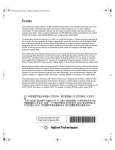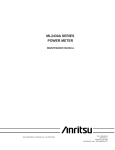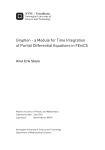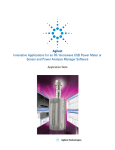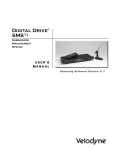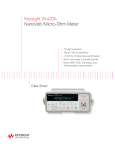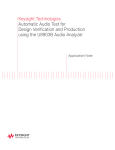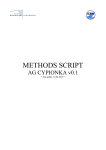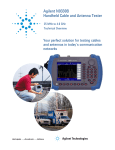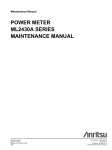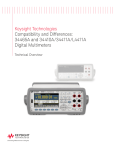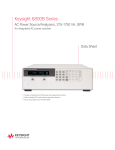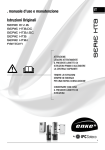Download 1mW 50 MHz Power Reference Measurement with the
Transcript
Keysight Technologies 1 mW 50 MHz Power Reference Measurement with the N432A Thermistor Power Meter Application Note Introduction This application note explains the application procedure for using the N432A with the thermistor mount to measure the power reference source of power meters. The first part of the article focuses on the fundamentals of the power reference measurement requirements. The second section provides step-by-step instructions for performing the measurement using the N432A thermistor power meter. The third part includes the measurement uncertainty or expected measurement error, which is a basic statistical method of obtaining the total measurement uncertainty. The final part of the article covers a brief overview of the new Keysight Technologies, Inc. N432A thermistor power meter. Why Calibrate the Power Reference? Measuring or verifying the 1 mW (0 dBm) 50 MHz power reference source is one of the key tasks when performing the annual service or calibration on RF power meters. In calibration laboratories or service facilities, engineers and technicians calibrate and measure the power reference in order to maintain the power meter’s measurement accuracy. In other words, maintaining the accuracy and traceability of the power reference indirectly minimize the power meter’s measurement uncertainty. All existing RF power meters, such as the Keysight Technologies EPM-P E4416/17A, EPM E4418/19B, and the N1913/14A, have a power reference source (also known as a reference calibrator) that has a typical specification of 1 mW ±0.5% (23 ±3 °C) or ±0.9% (0 to 55 °C) (see Figure 1). Figure 1. 1 mW (0 dBm) 50 MHz power reference calibrator on power meters When measuring RF power, the calibration factor corrections done within the power meter (connected with a power sensor) are referenced to this 1 mW 50 MHz source. That is why prior to performing any direct power measurement using the power meter and sensor, it is necessary to zero and calibrate the meter to ensure the power measurement will be accurate. 03 | Keysight | 1mW 50 MHz Power Reference Measurement with the N432A Thermistor Power Meter - Application Note Why Calibrate the Power Reference? (continued) As shown in the Figure 2, the power reference measurement is traceable to the National Standard (NIST). In order to obtain an accurate measurement when calibrating the meter’s power reference, the use of a thermistor power meter such as the Keysight Technologies N432A is recommended. This is because this power meter combined with the thermistor mount has a very low uncertainty. We shall elaborate more on the measurement uncertainty in the later portion of this application note. National standard (NIST) microcalorimeter Transfer standard (NIST) bolometer Traceability Reference or working standard (calibration/standard labs instruments manufacturer) End user power meters N432A + 478A N432A + 8478B E4416/17A, E4418/19B N1911/12/13/14A Figure 2. NIST traceability of RF power measurement Measurement setup for the 1 mW 50 MHz power reference The typical measurement setup for testing the reference calibrators uses the N432A thermistor power meter with a Keysight 3458A 8.5 digit digital multimeter (DMM) as shown in Figure 3. This setup is widely used by calibration and metrology labs because the 3458A DMM provides superior accuracy and traceability. However, depending on the measurement accuracy needed, the 3458A DMM is optional. The N432A power meter has a built-in internal voltmeter to convert the DC bridge voltages to watts (or dBm). Optional Vcomp (+) N432A 3458A Vrf (-) Cable adaptor N4998A Thermistor power meter & sensor 478A or 8478B Figure 3. 1 mW 50 MHz power reference measurement setup Power meter under test 04 | Keysight | 1mW 50 MHz Power Reference Measurement with the N432A Thermistor Power Meter - Application Note DC bridge Vcomp and VRF measurement The N432A has an internal digitizer that resembles a built-in digital voltmeter (DVM), providing an equivalent 6.5 digit DVM voltage measurement on the internal DC bridges. A simplified block diagram of the internal N432A is shown in Figure 4. There are two DC bridge circuits, the first bridge is called RF bridge and detects the RF power. The second circuit is called the compensated bridge and compensates for environmental temperature drift. The readings of the ambient thermistor are used to correct the readings of the sensor thermistor. This dual bridge operation is called compensated mode. BIAS driving current Ruser 100 or 200 Ω 1kΩ BNC connectors at the rear panel – Thermistor mount 478A or 8478B RT 1kΩ + Signal conditioning ADC Differential amplifier Figure 4. N432A DC Wheatstone self balancing bridge The impact of this built-in DVM improves the overall power measurement of the meter. The resulting benefits of this feature are that an external DVM is not required for the power measurement and that the overall accuracy of the power measurement is better than that obtained using only the 432A analog thermistor power meter. Figure 5 shows the voltage measurements panel in N432A. Figure 5. N432A voltage measurement display However, both VCOMP and VRF are available at the two BNC connectors located at the rear panel of the N432A. This is similar to the legacy 432A power meter, and these voltages will be measured by the external DMM. 05 | Keysight | 1mW 50 MHz Power Reference Measurement with the N432A Thermistor Power Meter - Application Note Special thermistor mount 478A-H75/H76 or 8478-H01 Optional specialty thermistor mounts (Figure 6) are used when performing power reference measurement because these mounts provide the lowest mismatch or standing wave ratio (SWR) at 50 MHz. The 478A Option H75 or H76, and 8478B Option H01 provide only ≤ 1.05 of SWR at 50 MHz, compare to normal mounts which typically have a SWR of 1.3. The reason for using these special, factory-tuned low SWR at 50 MHz is to reduce the mismatch measurement uncertainty when these mounts are connected to the reference calibrator of the power meters. From past experience, mismatch errors can significantly impact the overall measurement uncertainty. Figure 6. Special-tuned low SWR at 50 MHz thermistor mounts Step-by-Step Power Reference Measurement Procedures 1. Connect the equipment as shown in Figure 2. 2. Set the 3458A DMM to measure the DCV. 3. Ensure that the N432A and the power meter under test have been powered on for at least 30 minutes before continuing. (This is the recommended warm up time.) 4. Zero the N432A making sure that the power reference of the power meter under test is turned off. 5. Round the DMM reading to two decimal places and record this reading as V0. This is the voltage measured between the VCOMP and VRF connectors when no RF power is applied (the calibrator reference is turned off). 6. Turn-on the power reference on the power meter under test. 7. Round the DMM reading to two decimal places and record this reading as V1 (the reading is typically about 80 mV). In other words, V1 is the voltage measured between the VCOMP and VRF connectors when the calibrator reference power is turned on. 8. Disconnect the DMM negative input lead from the VRF connector on the N432A and connect it to the N432A chassis ground. 9. Record the DMM reading result as Vcomp (typically this is about 4.8 V). VCOMP is the voltage of the temperature compensated bridge. 10. Calculate the power reference oscillator power using Equation 1. The value for R can be typically set as 200 Ω. The CF is the calibration factor for the thermistor mount at 50 MHz. It is typically set as 99%. 11. The expected power measurement results (calculated) should be 1 mW ±0.9%. P= 2Vcomp (V1 – V0 ) + V 20 – V 21 4 × R × CF Equation 1 06 | Keysight | 1mW 50 MHz Power Reference Measurement with the N432A Thermistor Power Meter - Application Note Power Measurement Uncertainty Power measurement uncertainty equation The measurement uncertainty for measuring the 1 mW reference calibrators is based on the power measurement shown in Equation 2. The equation is a modified version of Equation 1 and includes the mismatch term (M) to account for the imperfect power transfer from the power reference (power meter under test) to the thermistor mount. P= 2Vcomp (V1 – V0 ) + V 2 0 –V 2 1 Equation 2 4 × R × CF × M M is the maximum (worst case) mismatch uncertainty between the calibrator reference to be measured and the thermistor mounts connector. It takes the form (1±2Gs x Gd), where Gs is the power reference reflection coefficient and Gd is thermistor mount reflection coefficient. N432A power measurement uncertainty model assessment Typically the power measurement uncertainty assessment is obtained using the uncertainty tabulated budget model. The assessment starts by collecting all the uncertainty contributors, in this case they are VCOMP, V0, V1, R, CF, and M. The root sum square (RSS) of the total uncertainty contributors is then calculated. This is called the RSS method. Table 1 shows an example of the 1 mW power reference measurement uncertainty based on set up shown in Figure 2. The content has been simplified and only shows the individual contributions of each parameter in Equation 2. Refer to Keysight’s application note Keysight Fundamentals of RF and Microwave Power Measurements, application note 1449-3, literature number 5989-7083EN for details. The result shows that the total measurement uncertainty using N432A thermistor power meter and sensor is 0.46%. Table 1. Measurement uncertainty budget table (with 3458A) Uncertainty contributors Units Value ± Limits Uncertainty contributed (standard uncertainty x sensitivity) Voltage measurement for Vcomp V 4.8 0.00003845 4.67 x 10-9 Voltage measurement for V1 V 0.080 0.00000098 6.77 x 10-9 Voltage measurement for V0 V 0.0023 0.00000032 –2.23 x 10-9 Bridge resistance measurement, R Ω 200 0.00250 –7.35 x 10-9 CF (calibration factor) Ratio 0.99 0.004 (calibrated by standard lab) –2.06 x 10-6 M (mismatch uncertainty) Ratio 1.00 0.00142 (2 x Gs x Gd) –1.02 x 10-6 Root sum square 2.29 x 10-6 Coverage factor, k = 2 for 95% confidence 2 Expanded uncertainty 4.59 x 10-6 Expanded uncertainty in % for 1 mW 0.4597 07 | Keysight | 1mW 50 MHz Power Reference Measurement with the N432A Thermistor Power Meter - Application Note N432A power measurement uncertainty model assessment (continued) As mentioned earlier, the measurement setup shown in Figure 2 can be simplified by eliminating the use of the 3458A. The voltage measurements (VCOMP, V0, and V1) will rely on the internal ADC measurement accuracy of the N432A. Hence the measurement uncertainty assessment will yield different results. Table 2 shows an example for such a scenario and the results show a very small difference from the measurement uncertainty model with the 3458A DMM. The improvement of the voltage measurement from 6.5 digit (N432A internal) to 8.5 digit (3458A) external yield is a non-significant improvement in terms of the measurement uncertainty. More importantly, in both cases, the CF and mismatch uncertainty always dominants the total uncertainty. Table 2. Measurement uncertainty budget table (standalone N432A) Uncertainty contributors Units Value ± Limits Uncertainty contributed (standard uncertainty x sensitivity) Voltage measurement for Vcomp V 4.78 0.00066730 8.14 x 10-8 Voltage measurement for V1 V 0.081 0.00001043 7.15 x 10-8 Voltage measurement for V0 V 0.0023 0.00000709 –4.95 x 10-8 Bridge resistance measurement, R Ω 200 0.00250 –7.35 x 10-9 CF (calibration factor) Ratio 0.99 0.004 (calibrated by standard lab) –2.06 x 10-6 M (mismatch uncertainty) Ratio 1.00 0.00142 (2 x Gs x Gd) –1.02 x 10-6 Root sum square 2.31 x 10-6 Coverage factor, k = 2 for 95% confidence 2 Expanded uncertainty 4.62 x 10-6 Expanded uncertainty in % for 1 mW 0.4620 08 | Keysight | 1mW 50 MHz Power Reference Measurement with the N432A Thermistor Power Meter - Application Note Brief Introduction to the N432A Thermistor Power Meter The N432A meter is the replacement model for the 432A power meter and includes enhancements and exciting features. This N432A thermistor power meter works perfectly with Keysight temperature-compensated thermistor mount sensors (478A and 8478B). Together with these sensors, the meter measures RF power from –30 to +10 dBm and cover the frequency range from 100 kHz to 18 GHz. It is the highest-accuracy power meter offered by Keysight. The N432A operates on the basis of a DC self-balancing Wheatstone bridge which shall be elaborated on later. Hence, the N432A is the only RF power meter with a DC substitution measurement, enabling it to convert RF power to a DC measurement such as voltage (V) and resistance (Ω). This ability is why the meter is widely used in metrology and calibration labs worldwide to calibrate power meters and sensors, and for any application which requires accurate RF power measurement. In addition to the external VCOMP and VRF connectors at the rear panel, the new N432A has a built-in digital voltmeter (DVM). It is simply an internal ADC circuit that digitizes the VCOMP and VRF voltage measurements and displays the results on the front of the meter. The users can select which measurement results to display, ranging from power measurement (dBm, watts) to the voltage measurements (VRF, VCOMPENSATED, V0 and V1). This whole digitization resembles a digital voltmeter (DVM) that’s built inside the power meter, giving equivalent 6.5 digit DVM voltage measurement results. 09 | Keysight | 1mW 50 MHz Power Reference Measurement with the N432A Thermistor Power Meter - Application Note Conclusion Over the years, thermistor-based power meters have been used to measure and calibrate the 1 mW 50 MHz power reference calibrator of RF power meters because of their accuracy, reliability, and traceability to standard labs. As shown in the power measurement uncertainty examples, these power meters (using a special thermistor mount) provide a very low uncertainty which is around 0.5%. The use of an external 3458A DMM to measure the VCOMP, V0, and V1 directly from the N432A power meter is a preferable setup for calibration and the standard lab because it is a more direct, traceable method and provides greater accuracy. From the two examples shown, it is clear that the two most significant contributors are the mismatch error and the CF uncertainty. Hence to maintain low mismatch uncertainty, a super low reflection coefficient thermistor sensor is to be used. To reduce CF uncertainty, make sure the sensor is calibrated at the standard metrology labs to maintain consistency, low uncertainty, and minimum drift. Reference 1. Radio Frequency & Microwave Power Measurement, Alan Fantom, IEEE, ISBN: 0 86341 120 7, 1990 2. Keysight Fundamentals of RF and Microwave Power Measurements, application note 1449-3, literature number 5989-7083EN 3. Keysight N432A Thermistor Power Meter, technical overview, literature number 5990-6168EN 4. Measuring RF Power, Joe Carr, Electronic World, November 1999 5. Keysight EPM-P E4416/17A, service manual, part number E4416-90014 6. Keysight N432A Thermistor Power Meter, user manual, part number N432A-90002 10 | Keysight | 1mW 50 MHz Power Reference Measurement with the N432A Thermistor Power Meter - Application Note myKeysight www.keysight.com/find/mykeysight A personalized view into the information most relevant to you. www.axiestandard.org AdvancedTCA® Extensions for Instrumentation and Test (AXIe) is an open standard that extends the AdvancedTCA for general purpose and semiconductor test. Keysight is a founding member of the AXIe consortium. ATCA®, AdvancedTCA®, and the ATCA logo are registered US trademarks of the PCI Industrial Computer Manufacturers Group. www.lxistandard.org LAN eXtensions for Instruments puts the power of Ethernet and the Web inside your test systems. Keysight is a founding member of the LXI consortium. www.pxisa.org PCI eXtensions for Instrumentation (PXI) modular instrumentation delivers a rugged, PC-based high-performance measurement and automation system. Three-Year Warranty www.keysight.com/find/ThreeYearWarranty Keysight’s commitment to superior product quality and lower total cost of ownership. The only test and measurement company with three-year warranty standard on all instruments, worldwide. Keysight Assurance Plans www.keysight.com/find/AssurancePlans Up to five years of protection and no budgetary surprises to ensure your instruments are operating to specification so you can rely on accurate measurements. www.keysight.com/go/quality Keysight Technologies, Inc. DEKRA Certified ISO 9001:2008 Quality Management System Keysight Channel Partners www.keysight.com/find/channelpartners Get the best of both worlds: Keysight’s measurement expertise and product breadth, combined with channel partner convenience. www.keysight.com/find/N432A For more information on Keysight Technologies’ products, applications or services, please contact your local Keysight office. The complete list is available at: www.keysight.com/find/contactus Americas Canada Brazil Mexico United States (877) 894 4414 55 11 3351 7010 001 800 254 2440 (800) 829 4444 Asia Pacific Australia China Hong Kong India Japan Korea Malaysia Singapore Taiwan Other AP Countries 1 800 629 485 800 810 0189 800 938 693 1 800 112 929 0120 (421) 345 080 769 0800 1 800 888 848 1 800 375 8100 0800 047 866 (65) 6375 8100 Europe & Middle East Austria Belgium Finland France Germany Ireland Israel Italy Luxembourg Netherlands Russia Spain Sweden Switzerland United Kingdom 0800 001122 0800 58580 0800 523252 0805 980333 0800 6270999 1800 832700 1 809 343051 800 599100 +32 800 58580 0800 0233200 8800 5009286 800 000154 0200 882255 0800 805353 Opt. 1 (DE) Opt. 2 (FR) Opt. 3 (IT) 0800 0260637 For other unlisted countries: www.keysight.com/find/contactus (BP-09-23-14) This information is subject to change without notice. © Keysight Technologies, 2011 - 2014 Published in USA, August 1, 2014 5990-9078EN www.keysight.com










